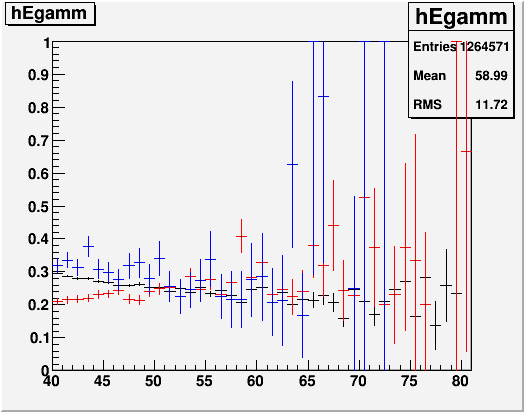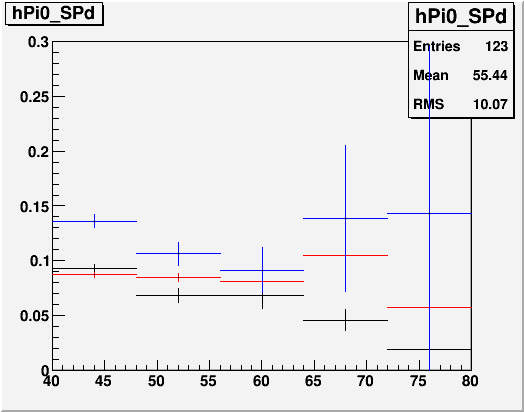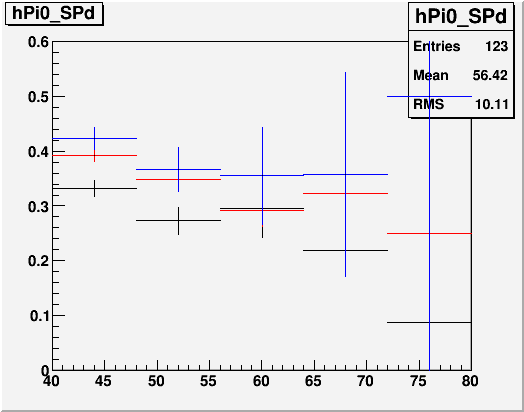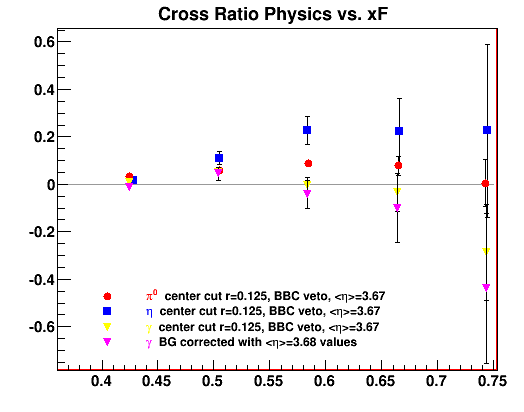- leun's home page
- Posts
- 2013
- 2012
- December (2)
- October (3)
- September (2)
- August (1)
- July (4)
- June (4)
- May (2)
- April (3)
- March (5)
- February (5)
- January (5)
- 2011
- December (3)
- November (3)
- September (5)
- August (2)
- July (2)
- June (3)
- May (4)
- April (4)
- March (2)
- February (4)
- January (2)
- 2010
- December (2)
- November (3)
- October (3)
- September (5)
- August (6)
- July (2)
- June (4)
- May (3)
- April (4)
- March (4)
- February (2)
- January (4)
- 2009
- 2008
- October (1)
- My blog
- Post new blog entry
- All blogs
FMS meeting 20110606
Data driven BG subtraction
Since we've already measured the cross-section for pi0 and eta, it's in principle possible to do BG correction based on that result. But the trouble is that it then brings in the issue of energy scale to an extent that we didn't normally have to deal with in asymmetry measurements. That is, the difference in energy scale between 1 and 2 photon events need to be well understood, and well simulated. The differences can come from,
1. Energy dependent gain shift. Clearly, the shift you get from two 20 GeV photons vs. one 40 GeV photon is not the same
2. Difference in reconstructed energy, depending on the number of photons. We already know this depends on the event topology even within 2 photon events. It's not a priori clear whether this wil be well simulated, since we know that the shower shape is still not exactly the same in data and simulation.
I've ran single photon only simulation to study this, and so far my conclusion is that the energy dependent gain shift is sufficiently linear in energy, that a constant offset in correction factor (~2.5%) between 1 and 2 photon energy seems to be workable. As for the difference in reconstructed energy, it's a little difficult to know exactly what to measure, but looking at the ratio between reconstructed and deposited energy leads me to believe that the simulation is off by less than 0.5%. More study is needed.
Black: Data
Red: Full simulation, Pythia filter at 40 GeV
Blue: Full simulation, Pythia filter at 28 GeV
Fig. 1. N_{single photon} / N_{pi0} vs. reconstructed energy

The ratio of single photon events to pi0 is lower around pythia filter threshold. The filter included all energy, (not just EM) but due to substantial width in energy resolution, it's important to be away from the threshold. Even so, the difference is larger than what I would've expected.
Fig. 2. N_{pi0 with only 1 photon in FPD} / N_{pi0 with two photons in FPD} vs. reconstructed energy

Again, it's unclear how this ratio can be so different for the two simulations in the first two bins. The effect of threshold should be similar to both classes of events, and I don't yet know why one photon events are more suppressed than two photon near threshold. Data plot is calculated based on the mixture of the two simulations.
Fig. 3. N_{pi0 with only 1 photon in FPD} / N_{single photons} vs. reconstructed energy

Fig. 4. AN vs. xF. BG subtraction was done only for pi0 induced packgrounds, but not the eta.

Binning has been changed from the last time, in order to match it with the cross-section measurement.
20110613 UPDATE
Background correction is still underway, but this is what we have at this point. Now both pi0 and eta are subtracted out. The error estimnation fo the background correction is a little better than the last time, but it's still shady.
Fig. 5

- leun's blog
- Login or register to post comments
